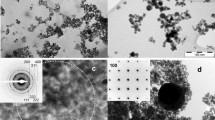Abstract
Vacuum-arc synthesis of nanopowders based on zirconia and metal-organic framework structures was carried out using low-pressure arc discharge plasma. The obtained material was studied using a number of techniques (XRD, IR, TEM, DTA). The TEM technique showed that Zr-MOF represents strongly agglomerated particles of nearly spherical shape. The image clearly shows the crystal ordering of the nanoparticles with a large (up to 2 nm) lattice constant. The sizes of particles vary in the range from 5 to 30 nm. The mean particle size is 9.4 nm. XRD showed that the fraction of ZrO relative to Zr-MOF calculated according to the most intense lines of the X-ray diffraction pattern is 65%. Results of XRD agree well with IR studies. The DTA curve shows a continuous exothermic process, which is associated with a number of features of plasma chemical synthesis and morphology of the obtained nanoparticles, which is in full accordance with the study using transmission electron microscopy.






Similar content being viewed by others
REFERENCES
Bai, Y., Dou, Y., **e, L.-H., Rutledge, W., Li, J.-R., and Zhou, H.-C., Zr-based metal—organic frameworks: Design, synthesis, structure, and applications, Chem. Soc. Rev., 2016, vol. 45, pp. 2327–2367.
Cavka, J.H., Jakobsen, S., Olsbye, U., Guillou, N., Lamberti, C., Bordiga, S., and Lillerud, K.P., A new zirconium inorganic building brick forming metal organic frameworks with exceptional stability, J. Am. Chem. Soc., 2008, vol. 130, pp. 13850–13851.
Wang, T.C., Bury, W., Gomez-Gualdron, D.A., Vermeulen, N.A., Mondloch, J.E., Deria, P., Zhang, K., Moghadam, P.Z., Sarjeant, A.A., Snurr, R.Q., Stoddart, J.F., Hupp, J.T., and Farha, O.K., Ultrahigh surface area zirconium MOFs and insights into the applicability of the bet theory, J. Am. Chem. Soc., 2015, vol. 137, pp. 3585–3591.
Furukawa, H., Gandara, F., Zhang, Y.-B., Jiang, J., Queen, W.L., Hudson, M.R., and Yaghi, O.M., Water adsorption in porous metal–organic frameworks and related materials, J. Am. Chem. Soc., 2014, vol. 136, pp. 4369–4381.
Gong, W., Chen, X., Jiang, H., Chu, D.D., Cui, Y., and Liu, Y., Highly stable Zr(IV)—based metal–organic frameworks with chiral phosphoric acids for catalytic asymmetric tandem reactions, J. Am. Chem. Soc., 2019, vol. 141, no. 18, pp. 7498–7508.
Zhu, J., Usov, P.M., Xu, W., Celis-Salazar, P.J., Lin, S., Kessinger, M.C., Landaverde-Alvarado, C., Cai, M., May, A.M., Slebodnick, C., Zhu, D., Senanayake, S.D., and Morris, A.J., A new class of metal-cyclam-based zirconium metal–organic frameworks for CO2 adsorption and chemical fixation, J. Am. Chem. Soc., 2018, vol. 140, pp. 993–1003.
He, Y., Tang, Y.P., Ma, D., and Chun, T.-S., UiO-66 incorporated thin-film nanocomposite membranes for efficient selenium and arsenic removal, J. Membr. Sci., 2017, vol. 541, pp. 262–270.
Lazaro, I.A. and Forgan, R.S., Application of zirconium MOFs in drug delivery and biomedicine, Coord. Chem. Rev., 2019, vol. 380, pp. 230–259.
Chen, D., Yang, D., Dougherty, C.A., Lu, W., Wu, H., He, X., Cai, T., Van Dort, M.E., Ross, B.D., and Hong, H., In vivo targeting and positron emission tomography imaging of tumor with intrinsically radioactive metal–organic frameworks nanomaterials, ACS Nano, 2017, vol. 11, pp. 4315–4327.
Goswami, S., Ray, D., Otake, K.-I., Kung, C.-W., Garibay, S.J., Islamoglu, T., Atilgan, A., Cui, Y., Cramer, C.J., Farha, O.K., and Hupp, J.T., A porous, electrically conductive hexa-zirconium (IV) metal–organic framework, Chem. Sci., 2018, vol. 9, pp. 4477–4482.
Burtch, N.C., Jasuja, H., and Walton, K.S., Water stability and adsorption in metal–organic frameworks, Chem. Rev., 2014, vol. 114, pp. 10575–10612.
Ushakov, A.V., Karpov, I.V., Fedorov, L.Yu., Dorozhkina, E.A., Karpova, O.N., Shaikhadinov, A.A., Demin, V.G., Demchenko, A.I., Brungardt, M.V., and Goncharova, E.A., Formation of CuO and Cu2O crystalline phases in a reactor for low-pressure arc discharge synthesis, Inorg. Mater.: Appl. Res., 2020, vol. 11, pp. 232–237. https://doi.org/10.1134/S2075113320010372
Funding
This work was supported by the Russian Foundation for Basic Research, the Government of the Krasnoyarsk Krai, the Regional Foundation of Science, and OOO Seismiklab (project no. 20-48-242904).
Author information
Authors and Affiliations
Corresponding author
Ethics declarations
The authors declare that they have no conflicts of interest.
Additional information
Translated by A. Muravev
Rights and permissions
About this article
Cite this article
Karpov, I.V., Ushakov, A.V., Fedorov, L.Y. et al. Vacuum-Arc Synthesis of Metal-Organic Framework Structures Based on ZrO2. Inorg. Mater. Appl. Res. 13, 924–928 (2022). https://doi.org/10.1134/S2075113322040165
Received:
Revised:
Accepted:
Published:
Issue Date:
DOI: https://doi.org/10.1134/S2075113322040165




